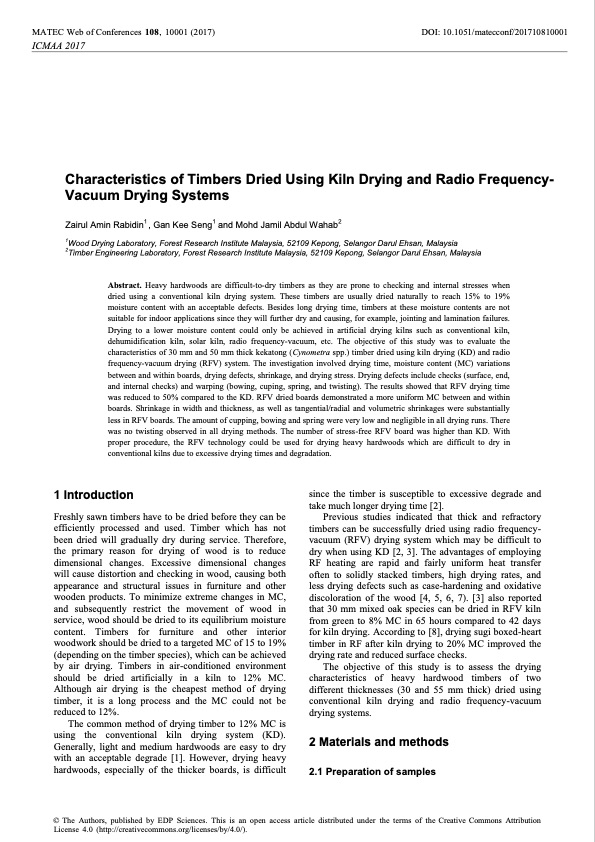
PDF Publication Title:
Text from PDF Page: 001
MATEC Web of Conferences 108, 10001 (2017) DOI: 10.1051/matecconf/201710810001 ICMAA 2017 Characteristics of Timbers Dried Using Kiln Drying and Radio Frequency- Vacuum Drying Systems Zairul Amin Rabidin1 , Gan Kee Seng1 and Mohd Jamil Abdul Wahab2 1Wood Drying Laboratory, Forest Research Institute Malaysia, 52109 Kepong, Selangor Darul Ehsan, Malaysia 2Timber Engineering Laboratory, Forest Research Institute Malaysia, 52109 Kepong, Selangor Darul Ehsan, Malaysia Abstract. Heavy hardwoods are difficult-to-dry timbers as they are prone to checking and internal stresses when dried using a conventional kiln drying system. These timbers are usually dried naturally to reach 15% to 19% moisture content with an acceptable defects. Besides long drying time, timbers at these moisture contents are not suitable for indoor applications since they will further dry and causing, for example, jointing and lamination failures. Drying to a lower moisture content could only be achieved in artificial drying kilns such as conventional kiln, dehumidification kiln, solar kiln, radio frequency-vacuum, etc. The objective of this study was to evaluate the characteristics of 30 mm and 50 mm thick kekatong (Cynometra spp.) timber dried using kiln drying (KD) and radio frequency-vacuum drying (RFV) system. The investigation involved drying time, moisture content (MC) variations between and within boards, drying defects, shrinkage, and drying stress. Drying defects include checks (surface, end, and internal checks) and warping (bowing, cuping, spring, and twisting). The results showed that RFV drying time was reduced to 50% compared to the KD. RFV dried boards demonstrated a more uniform MC between and within boards. Shrinkage in width and thickness, as well as tangential/radial and volumetric shrinkages were substantially less in RFV boards. The amount of cupping, bowing and spring were very low and negligible in all drying runs. There was no twisting observed in all drying methods. The number of stress-free RFV board was higher than KD. With proper procedure, the RFV technology could be used for drying heavy hardwoods which are difficult to dry in conventional kilns due to excessive drying times and degradation. 1 Introduction Freshly sawn timbers have to be dried before they can be efficiently processed and used. Timber which has not been dried will gradually dry during service. Therefore, the primary reason for drying of wood is to reduce dimensional changes. Excessive dimensional changes will cause distortion and checking in wood, causing both appearance and structural issues in furniture and other wooden products. To minimize extreme changes in MC, and subsequently restrict the movement of wood in service, wood should be dried to its equilibrium moisture content. Timbers for furniture and other interior woodwork should be dried to a targeted MC of 15 to 19% (depending on the timber species), which can be achieved by air drying. Timbers in air-conditioned environment should be dried artificially in a kiln to 12% MC. Although air drying is the cheapest method of drying timber, it is a long process and the MC could not be reduced to 12%. The common method of drying timber to 12% MC is using the conventional kiln drying system (KD). Generally, light and medium hardwoods are easy to dry with an acceptable degrade [1]. However, drying heavy hardwoods, especially of the thicker boards, is difficult since the timber is susceptible to excessive degrade and take much longer drying time [2]. Previous studies indicated that thick and refractory timbers can be successfully dried using radio frequency- vacuum (RFV) drying system which may be difficult to dry when using KD [2, 3]. The advantages of employing RF heating are rapid and fairly uniform heat transfer often to solidly stacked timbers, high drying rates, and less drying defects such as case-hardening and oxidative discoloration of the wood [4, 5, 6, 7). [3] also reported that 30 mm mixed oak species can be dried in RFV kiln from green to 8% MC in 65 hours compared to 42 days for kiln drying. According to [8], drying sugi boxed-heart timber in RF after kiln drying to 20% MC improved the drying rate and reduced surface checks. The objective of this study is to assess the drying characteristics of heavy hardwood timbers of two different thicknesses (30 and 55 mm thick) dried using conventional kiln drying and radio frequency-vacuum drying systems. 2 Materials and methods 2.1 Preparation of samples © The Authors, published by EDP Sciences. This is an open access article distributed under the terms of the Creative Commons Attribution License 4.0 (http://creativecommons.org/licenses/by/4.0/).PDF Image | Characteristics of Timbers Dried Using Kiln Drying

PDF Search Title:
Characteristics of Timbers Dried Using Kiln DryingOriginal File Name Searched:
Characteristics_of_Timbers_Dried_Using_Kiln_Drying.pdfDIY PDF Search: Google It | Yahoo | Bing
5,000 BF Shipping Container Lumber Dry Kiln For Quality Lumber The 5,000 BF container kiln consists of one 40 foot high-cube aluminum shipping container... More Info
Shipping Container Lumber Dry Kilns by Global Energy Global Energy designed and developed the container kiln back in 1991. The purpose is to give access to portable sawmill owners, furniture makers, and small business the value added profit of dry kiln lumber and quality hardwoods... More Info
Vacuum Kiln Conversion Kit for Lumber and Wood Dry Kilns Convert your existing conventional dry kiln into a fast drying vacuum kiln. Similar to vacuum bagging in the boat building and aircraft industry, we have come up with a proprietary process which allows you to build a very simple vacuum kiln at a fraction of the price, and without the intensive conventional metal chamber structure... More Info
Vacuum Pump Cart System for Bagging Clamping Wood Drying and more Vacuum Cart with 2HP Pump and Dual Pistons with multiple multiplex vacuum ports and liquid reservoir... More Info
Vacuum Bagging Basics Vacuum bagging is a method of clamping, which has traditionally been used in the composites industry, but can also be used for vacuum drying materials, including wood products... More Info
| CONTACT TEL: 608-238-6001 Email: greg@globalmicroturbine.com | RSS | AMP |